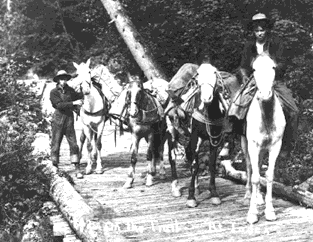
PERSPECTIVE ON THE PAST
He was a saddle-worn man, creased face tanned by exposure to the sun and weather of the mountain-. Middle height, tough muscled beneath a faded flannel shirt, blue jeans washed until almost white, sweat-stained hat, and around his hips, a dark brown cartridge belt. Softly cradled in the holster nestled a .38 caliber revolver. The gun fit the man. Both had been well used.
That was my introduction to the packer, the man with a string of horses or mules who hauled in the freight which was too heavy or in too great a quantity for a man's back.
In this case we were maintaining trails oil' the Suiattle River near Glacier Peak in eastern Snohomish County, but the packer could have been found in most of our area not many years ago.
The native people usually traveled by canoe; large and prowed for salt water paddling, slim and swift, for upriver poling. Where you couldn't go by water you walked on trails.
Early British and Americans traveled by canoe and only gradually built trails along with a few muddy ruts classified as wagon roads. Those "roads" were expensive and difficult, dodging stumps, slides and blown down trees.
Hence the packer. Early trails left the small water-side twons and were built parallel along the streams. When silver and gold brought prospectors to the river tributaries in the 1870's and 1890's, new routes were pushed into isolated eastern Snohomish County such as up Sfiver Creek from the Skykomish River, and from Sauk City on the Skagit up the Sauk River toward Monte Cristo.
During the 1920's and 1930's hundreds of miles of trails were constructed in the mountains as the U.S. Forest Service trifled to build access routes into its new domain.
Fire control was the main concern, with lookout buidiigs placed high on mountain tops to watch over the land. Foot paths were cleared and maintained to provide rapid access to the ridges.
Tents, food, and tools had to be freighted into fire camps, while the men -- often hired off the skid rows and from pool hahs -- had to walk. Street shoes, simple working clothes, and dangerous, poorly paid labor were not conducive to top. quality results.
Again, the packer was needed. U su ally riding a well tra i ned horse, leading a string of horses or mules, he was an expert with animals. He knew what they could carry, how far, and under what conditions. Often those conditions were extreme, as up the steep climb from the South Fork Sauk River to the mines in Gothic Basin.
In 1912 Walt Banta, packing for the Northwest Consolidated Mining Company, watched in horror as horses in his string lost their footing and plunged wildly off the trail down the steep cliff side. The mercy of a pistol shot to end the suffering of a maimed animal was the reason for carrying the .38.
Amy Banta told me that her husband's surviving horses never forgot that spot. Every time Walt led them up the trail they would pause there as iflooking for their lost friends.
From fingerling fish for stocking mountain streams to home brewed moonshine for easing stiff muscles after a hard day in the mine, the pack animals carried it all.
A toast then, to my packer friend and to all the men (and women such as Edith and Jean Bedal), their horses and mules, who hauled the ore, lumber, and store-bought shirts up and down those rugged trails. Not all that pioneer sweat and labor was human!
![]()
This web page is hosted by Mamoun Sakkal AIA,
architect